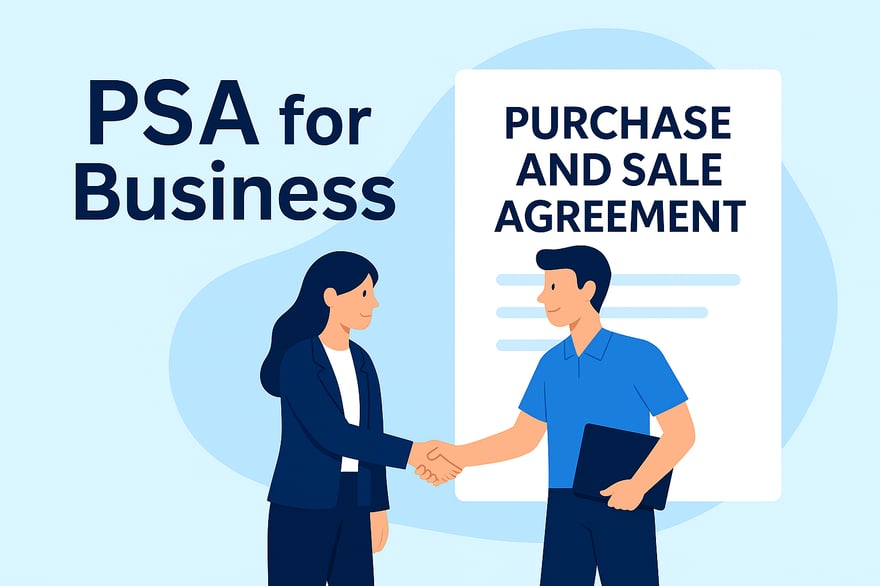
When businesses change hands — whether it’s selling a company outright, transferring a division, or buying major assets such as equipment or intellectual property — the deal doesn’t happen on a simple handshake. It happens through a purchase and sale agreement (PSA).
A PSA is the contract that governs the transaction. It sets out what’s being sold, at what price, and under what conditions. Just as importantly, it allocates risks between the buyer and the seller and provides legal protections if something goes wrong.
In other words: if you’re buying or selling a business, the PSA is the document that makes the deal real.
Purpose of a Purchase and Sale Agreement
A PSA is more than just paperwork; it’s the foundation of the business transaction. It spells out exactly what’s being bought or sold, under what conditions, and with what protections for both sides.
The main purposes of a PSA are:
Creating certainty before closing
The agreement defines the purchase price, which assets or shares are being transferred, what liabilities will remain, and what promises (warranties) each side is making. Establishing this shared sense of clarity up front reduces the chance of misunderstandings later.
Providing a framework for the deal
A PSA serves as the master guide to closing, setting out what has to happen — from financing and regulatory approvals to specific deliverables — before ownership changes hands.
Offering legal recourse if things go wrong
If a party fails to meet its obligations, the PSA provides remedies. This might include indemnification, dispute resolution procedures, or the right to walk away from the deal altogether.
The PSA transforms a handshake or a term sheet into a binding agreement that both allocates risk and gives each party confidence that the deal will proceed as intended.
Types of Deals That Use Purchase and Sale Agreements
PSAs aren’t one-size-fits-all. They’re used across different types of business transactions, each with its own implications for buyers and sellers:
Stock Purchases
The buyer purchases the seller’s shares and takes over ownership of the company — assets, liabilities, and all. Stock purchases are often simpler to execute on paper than other types of PSAs, but they come with greater risk exposure for the buyer.
Asset Purchases
Instead of buying the entire company, the buyer selects specific assets, such as IP, equipment, or customer lists. This approach can help the buyer avoid unwanted liabilities, but may require more detailed schedules to capture exactly what’s included.
Hybrid Transactions
Some deals blend both approaches, with buyers acquiring key assets while also taking on specified stock or liabilities. These can get complex quickly and often require carefully tailored PSAs.
Other Contexts
PSAs are most common in mergers and acquisitions (M&A), but they can also apply in real-estate-heavy transactions (such as when a company’s property is a major part of its value) or in partial divestitures, where only part of a business unit is being sold.
Common Clauses in a Business Purchase and Sale Agreement
While every deal is unique, most PSAs share a core set of clauses. These terms define the business deal, allocate risks, and provide remedies if things don’t go as planned. Key provisions include:
- Purchase price and payment terms: How much the buyer will pay, how they’ll pay it (lump sum, installments, or contingent payments such as earnouts), and the timing of payment.
- Representations and warranties: Statements and guarantees each party makes about the business and the transaction. For example, the seller may warrant that its financials are accurate and it owns the assets free of liens. If these promises turn out to be false, the buyer may have a claim.
- Indemnification: Closely tied to warranties, indemnification provisions spell out how costs are allocated if one party’s misstatements or breaches cause losses.
- Closing conditions: Requirements that must be satisfied before the deal is completed, such as regulatory approvals, financing, or delivery of key documents.
- Non-compete and non-solicit agreements: To protect the buyer’s investment, sellers are often restricted from immediately competing with the business or soliciting employees and customers after closing.
- Confidentiality: Obligations to protect sensitive business information shared during negotiations or transferred as part of the sale.
- Dispute resolution: Specifies how disputes will be resolved — e.g., through arbitration, mediation, or litigation — and in what jurisdiction.
Together, these clauses form a safety net for the transaction, ensuring that both sides know their rights and obligations from start to finish.
How a Purchase and Sale Agreement Differs from Similar Documents
Because PSAs often sit alongside other deal documents, it’s easy to confuse them. Here’s how a PSA differs:
PSA vs. Bill of Sale
A bill of sale functions more like a receipt: it confirms the transfer once the deal has closed. By contrast, a PSA governs the transaction itself. It sets out the terms, obligations, and conditions before closing, giving both sides legal recourse if something goes wrong along the way.
PSA vs. Letter of Intent or Term Sheet
A letter of intent (LOI) or term sheet usually comes first. These documents set out the initial deal terms but are often non-binding, meant to guide negotiations. The PSA is the binding contract that locks those terms in and adds detailed obligations, representations, and remedies.
PSA vs. Asset Transfer Agreement
An asset transfer agreement is typically narrower, focusing on the mechanics of transferring a specific set of assets. A PSA is broader in scope: it not only lists what’s being transferred, but also includes representations, indemnities, closing conditions, and dispute resolution mechanisms.
In short, the PSA is the backbone of the deal — the document that ties together preliminary agreements and narrower transfer instruments into a single, enforceable contract.
Challenges and Risks in Purchase and Sale Agreements
Even well-drafted PSAs carry risks. The details matter, and overlooking them can create expensive disputes or operational headaches down the road. Common pitfalls include:
Ambiguity in Definitions
A single undefined or unclear term can spark arguments later. For example, what counts as “material” when disclosing liabilities? Precision in definitions prevents misaligned expectations.
Overly Broad Warranties
Sellers often want to limit their promises; buyers want them more expansive. If warranties are too broad, sellers may face disproportionate liability for issues outside their control. If they’re too narrow, buyers lack protection.
Hidden Liabilities
Regulatory penalties, tax obligations, or employment disputes may not appear until after closing. Due diligence is essential, but so is drafting indemnities that allocate these risks fairly.
Financing Issues
Some deals depend on outside funding. If financing falls through, the buyer may be unable to close, leaving both sides exposed. Well-drafted PSAs address these contingencies directly.
Post-Closing Integration
Contracts can transfer assets and liabilities, but they can’t guarantee smooth cultural or operational integration. Buyers who ignore the human and systems side of the deal risk value leakage after the ink dries.
The PSA is a powerful safeguard…but it’s not bulletproof. Careful drafting, realistic negotiation, and thorough diligence are what keep these risks manageable.
Five Best Practices for Drafting and Reviewing Purchase and Sale Agreements
Getting a PSA right requires more than filling in blanks in a template; it demands coordination, precision, and a balance of detail with usability. Here are five best practices to follow:
- Bring legal in early. Too often, business teams start negotiating terms before the legal team reviews the draft. Involving counsel from the outset prevents contradictions with existing obligations and avoids costly rewrites.
- Keep the PSA aligned with preliminary documents. The LOI or term sheet sets the foundation. If the PSA drifts from those terms, the deal may stall while the parties renegotiate. Use the LOI as a checklist to ensure consistency.
- Treat definitions as mission-critical. Sloppy or inconsistent definitions are one of the biggest sources of disputes in business contracts. Double-check that every defined term is used correctly and that cross-references point to the right sections.
- Balance detail with high-level clarity. It’s tempting to draft a “kitchen sink” agreement that covers every possible scenario. But too much legalese can obscure meaning and slow down review. Aim for mutual understanding first, then add detail where the risk truly warrants it.
- Leverage helpful technology. Modern contract tools can automate cross-reference checks, flag undefined terms, and fix formatting issues that slow down review. Solutions like BoostDraft help teams catch errors early and keep drafting efficient, freeing lawyers to focus on negotiation strategy instead of Word cleanup.
Draft Purchase and Sale Agreements Better With BoostDraft
A PSA isn’t just a document to fill out and file; it defines the terms of the transaction, protects both parties, and serves as the legal backbone for the deal.
Because so much rides on the details, mistakes or oversights in a PSA can be costly. Careful drafting and thorough review are essential — and the right tools can make the process faster and more reliable.
Book a demo to see how BoostDraft helps teams review PSAs more efficiently, catch errors before they cause problems, and close deals with confidence.


